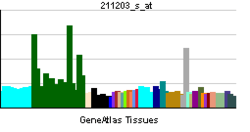CNTN1
| Contactin 1 | |||||||||||||
|---|---|---|---|---|---|---|---|---|---|---|---|---|---|
| |||||||||||||
| Identifiers | |||||||||||||
| Symbols | CNTN1 ; F3; GP135; MYPCN | ||||||||||||
| External IDs | OMIM: 600016 MGI: 105980 HomoloGene: 7274 GeneCards: CNTN1 Gene | ||||||||||||
| |||||||||||||
| RNA expression pattern | |||||||||||||
 | |||||||||||||
| More reference expression data | |||||||||||||
| Orthologs | |||||||||||||
| Species | Human | Mouse | |||||||||||
| Entrez | 1272 | 12805 | |||||||||||
| Ensembl | ENSG00000018236 | ENSMUSG00000055022 | |||||||||||
| UniProt | Q12860 | P12960 | |||||||||||
| RefSeq (mRNA) | NM_001256063 | NM_001159647 | |||||||||||
| RefSeq (protein) | NP_001242992 | NP_001153119 | |||||||||||
| Location (UCSC) | Chr 12: 41.09 – 41.47 Mb | Chr 15: 92.05 – 92.34 Mb | |||||||||||
| PubMed search | |||||||||||||
Contactin 1, also known as CNTN1, is a protein which in humans is encoded by the CNTN1 gene.[1][2]
Function
The protein encoded by this gene is a member of the immunoglobulin superfamily. It is a glycosylphosphatidylinositol (GPI)-anchored neuronal membrane protein that functions as a cell adhesion molecule. It may play a role in the formation of axon connections in the developing nervous system. Two alternatively spliced transcript variants encoding different isoforms have been described for this gene.[2]
Interactions
CNTN1 has been shown to interact with PTPRB.[3][4]
References
- ↑ Berglund EO, Ranscht B (June 1994). "Molecular cloning and in situ localization of the human contactin gene (CNTN1) on chromosome 12q11-q12". Genomics 21 (3): 571–82. doi:10.1006/geno.1994.1316. PMID 7959734.
- ↑ 2.0 2.1 "Entrez Gene: CNTN1 contactin 1".
- ↑ Sakurai, T; Lustig M; Nativ M; Hemperly J J; Schlessinger J; Peles E; Grumet M (February 1997). "Induction of neurite outgrowth through contactin and Nr-CAM by extracellular regions of glial receptor tyrosine phosphatase beta". J. Cell Biol. (UNITED STATES) 136 (4): 907–18. doi:10.1083/jcb.136.4.907. ISSN 0021-9525. PMC 2132488. PMID 9049255.
- ↑ Peles, E; Nativ M, Campbell P L, Sakurai T, Martinez R, Lev S, Clary D O, Schilling J, Barnea G, Plowman G D, Grumet M, Schlessinger J (July 1995). "The carbonic anhydrase domain of receptor tyrosine phosphatase beta is a functional ligand for the axonal cell recognition molecule contactin". Cell (UNITED STATES) 82 (2): 251–60. doi:10.1016/0092-8674(95)90312-7. ISSN 0092-8674. PMID 7628014.
Further reading
- Walsh FS, Doherty P (1992). "Glycosylphosphatidylinositol anchored recognition molecules that function in axonal fasciculation, growth and guidance in the nervous system.". Cell Biol. Int. Rep. 15 (11): 1151–66. doi:10.1016/0309-1651(91)90061-M. PMID 1838307.
- Peles E, Schlessinger J, Grumet M (1998). "Multi-ligand interactions with receptor-like protein tyrosine phosphatase beta: implications for intercellular signaling.". Trends Biochem. Sci. 23 (4): 121–4. doi:10.1016/S0968-0004(98)01195-5. PMID 9584610.
- Olive S, Dubois C, Schachner M, Rougon G (1995). "The F3 neuronal glycosylphosphatidylinositol-linked molecule is localized to glycolipid-enriched membrane subdomains and interacts with L1 and fyn kinase in cerebellum.". J. Neurochem. 65 (5): 2307–17. doi:10.1046/j.1471-4159.1995.65052307.x. PMID 7595520.
- Peles E, Nativ M, Campbell PL et al. (1995). "The carbonic anhydrase domain of receptor tyrosine phosphatase beta is a functional ligand for the axonal cell recognition molecule contactin.". Cell 82 (2): 251–60. doi:10.1016/0092-8674(95)90312-7. PMID 7628014.
- Berglund EO, Ranscht B (1994). "Molecular cloning and in situ localization of the human contactin gene (CNTN1) on chromosome 12q11-q12.". Genomics 21 (3): 571–82. doi:10.1006/geno.1994.1316. PMID 7959734.
- Reid RA, Bronson DD, Young KM, Hemperly JJ (1994). "Identification and characterization of the human cell adhesion molecule contactin.". Brain Res. Mol. Brain Res. 21 (1-2): 1–8. doi:10.1016/0169-328X(94)90372-7. PMID 8164510.
- Yoshihara Y, Kawasaki M, Tamada A et al. (1996). "Overlapping and differential expression of BIG-2, BIG-1, TAG-1, and F3: four members of an axon-associated cell adhesion molecule subgroup of the immunoglobulin superfamily.". J. Neurobiol. 28 (1): 51–69. doi:10.1002/neu.480280106. PMID 8586965.
- Sakurai T, Lustig M, Nativ M et al. (1997). "Induction of neurite outgrowth through contactin and Nr-CAM by extracellular regions of glial receptor tyrosine phosphatase beta.". J. Cell Biol. 136 (4): 907–18. doi:10.1083/jcb.136.4.907. PMC 2132488. PMID 9049255.
- Xiao ZC, Taylor J, Montag D et al. (1997). "Distinct effects of recombinant tenascin-R domains in neuronal cell functions and identification of the domain interacting with the neuronal recognition molecule F3/11.". Eur. J. Neurosci. 8 (4): 766–82. doi:10.1111/j.1460-9568.1996.tb01262.x. PMID 9081628.
- Xiao ZC, Hillenbrand R, Schachner M et al. (1997). "Signaling events following the interaction of the neuronal adhesion molecule F3 with the N-terminal domain of tenascin-R.". J. Neurosci. Res. 49 (6): 698–709. doi:10.1002/(SICI)1097-4547(19970915)49:6<698::AID-JNR4>3.0.CO;2-2. PMID 9335257.
- Pierre K, Rougon G, Allard M et al. (1998). "Regulated expression of the cell adhesion glycoprotein F3 in adult hypothalamic magnocellular neurons.". J. Neurosci. 18 (14): 5333–43. PMID 9651216.
- Revest JM, Faivre-Sarrailh C, Maeda N et al. (1999). "The interaction between F3 immunoglobulin domains and protein tyrosine phosphatases zeta/beta triggers bidirectional signalling between neurons and glial cells.". Eur. J. Neurosci. 11 (4): 1134–47. doi:10.1046/j.1460-9568.1999.00521.x. PMID 10103110.
- Berglund EO, Murai KK, Fredette B et al. (2000). "Ataxia and abnormal cerebellar microorganization in mice with ablated contactin gene expression.". Neuron 24 (3): 739–50. doi:10.1016/S0896-6273(00)81126-5. PMID 10595523.
- Pierre K, Dupouy B, Allard M et al. (2001). "Mobilization of the cell adhesion glycoprotein F3/contactin to axonal surfaces is activity dependent.". Eur. J. Neurosci. 14 (4): 645–56. doi:10.1046/j.0953-816x.2001.01682.x. PMID 11556889.
- Kazarinova-Noyes K, Malhotra JD, McEwen DP et al. (2001). "Contactin associates with Na+ channels and increases their functional expression.". J. Neurosci. 21 (19): 7517–25. PMID 11567041.
- Pavlou O, Theodorakis K, Falk J et al. (2002). "Analysis of interactions of the adhesion molecule TAG-1 and its domains with other immunoglobulin superfamily members.". Mol. Cell. Neurosci. 20 (3): 367–81. doi:10.1006/mcne.2002.1105. PMID 12139915.
- Strausberg RL, Feingold EA, Grouse LH et al. (2003). "Generation and initial analysis of more than 15,000 full-length human and mouse cDNA sequences.". Proc. Natl. Acad. Sci. U.S.A. 99 (26): 16899–903. doi:10.1073/pnas.242603899. PMC 139241. PMID 12477932.
- Garwood J, Heck N, Reichardt F, Faissner A (2003). "Phosphacan short isoform, a novel non-proteoglycan variant of phosphacan/receptor protein tyrosine phosphatase-beta, interacts with neuronal receptors and promotes neurite outgrowth.". J. Biol. Chem. 278 (26): 24164–73. doi:10.1074/jbc.M211721200. PMID 12700241.